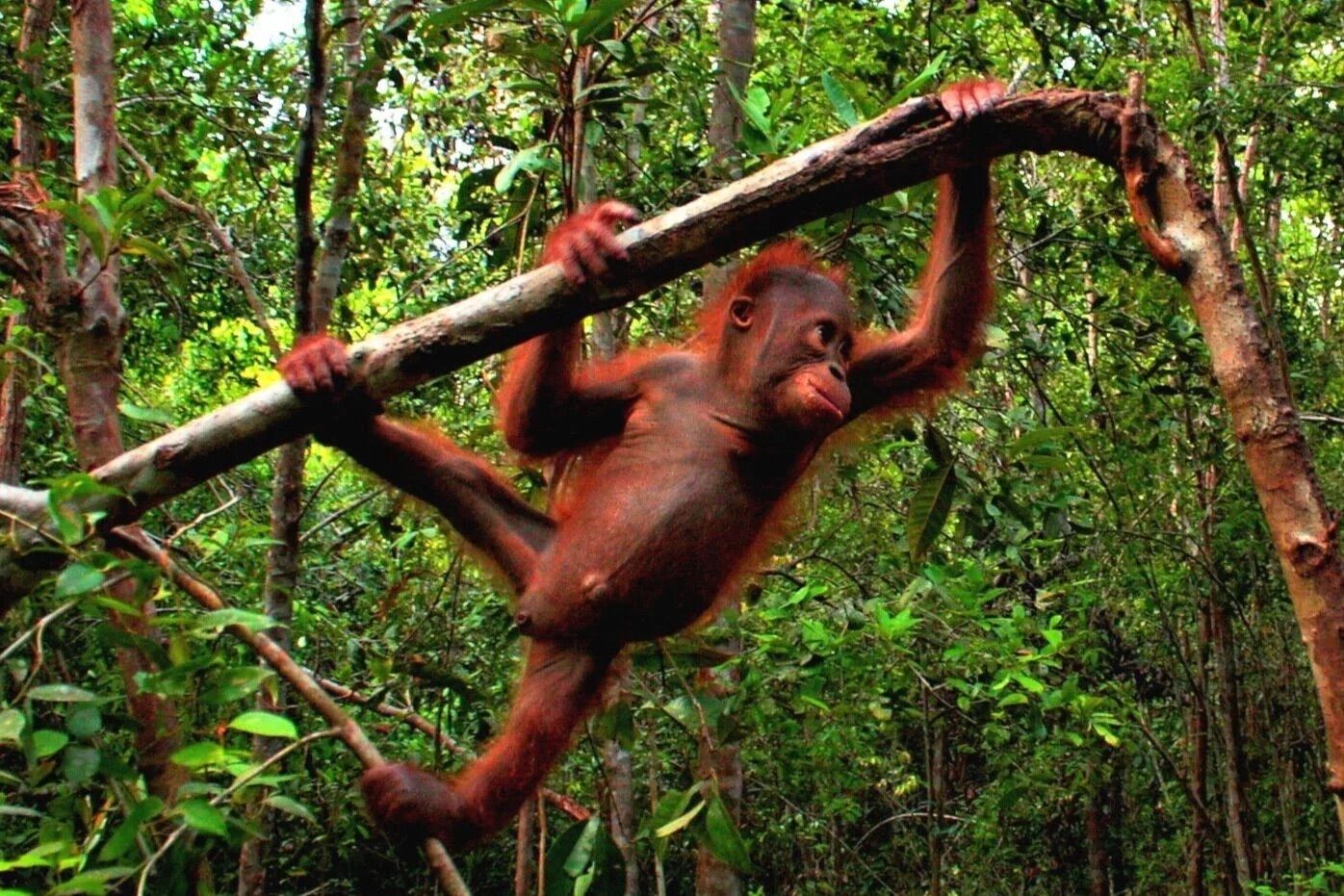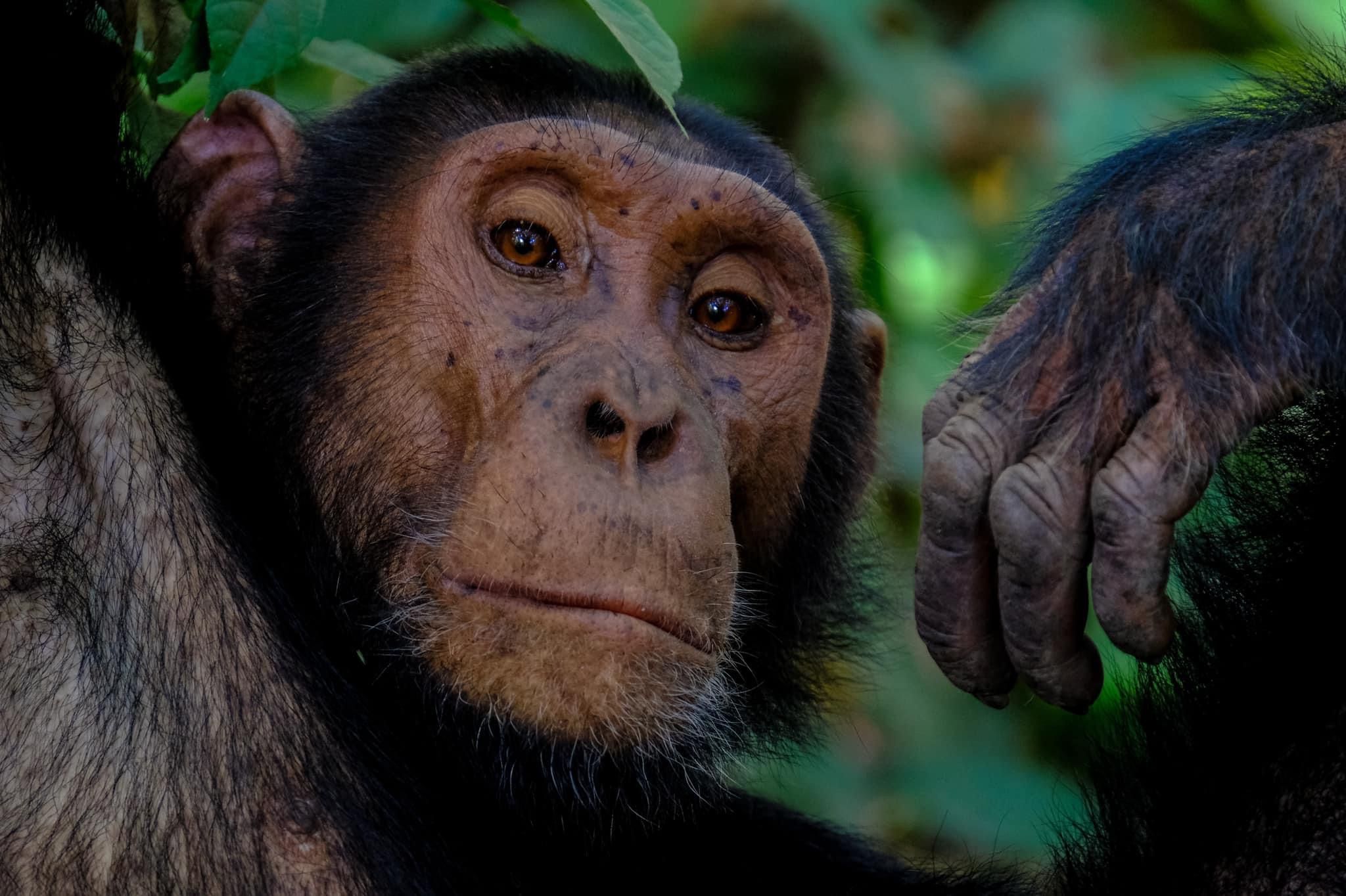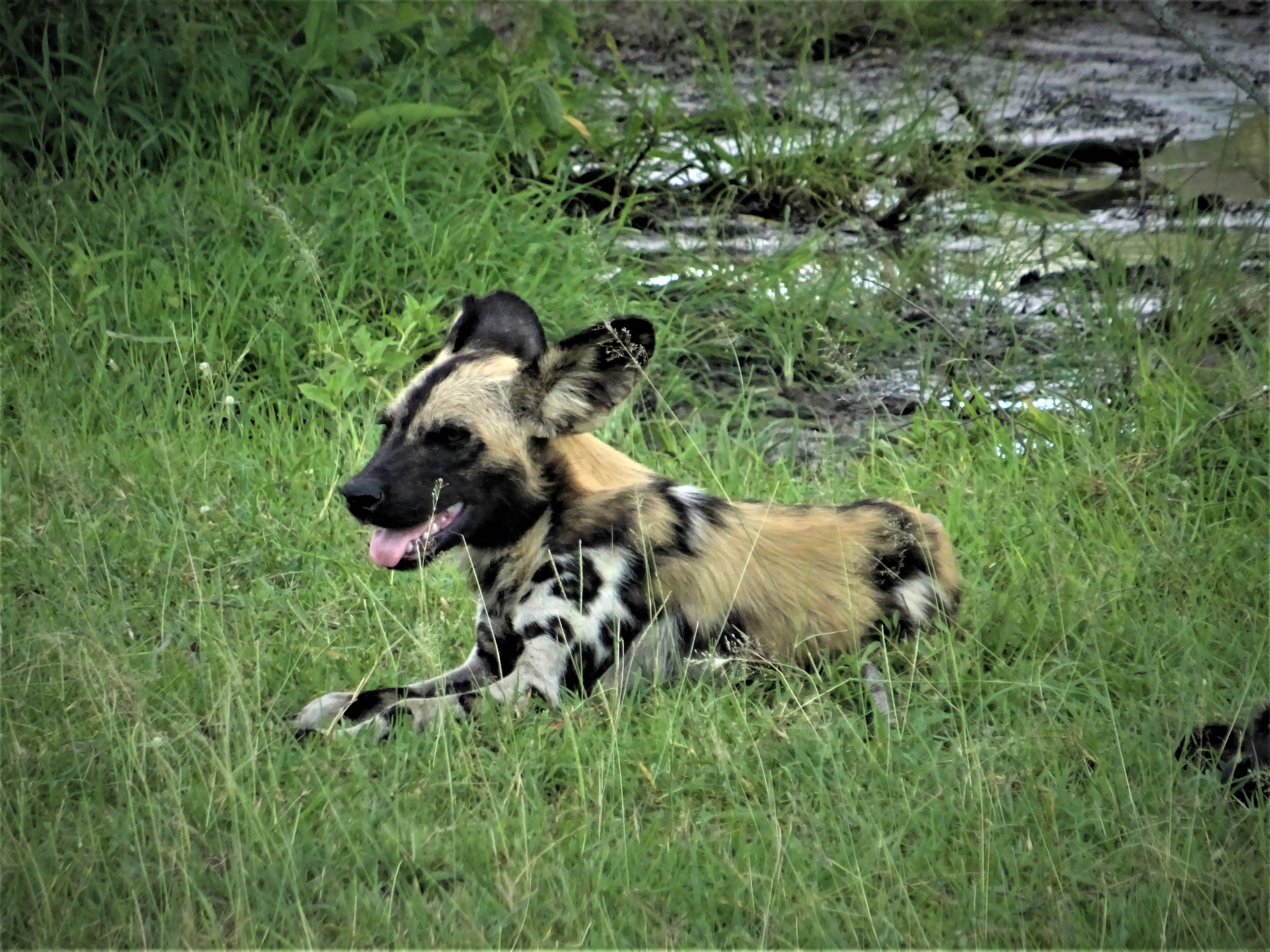So you want to go mountain gorilla trekking ! It’s an awesome idea! We’ve been, and we can tell you that it’s definitely, absolutely, positively worth it. It's one of Our favorite things to do in Uganda . Standing just a few feet from these gentle giants in their forest habitat and seeing them munch on fruits and plants, play with or groom one another, and idly look at the curious bipeds looking at them – these are magical moments that stay with you for a lifetime. But to get to be in that special place, you first must decide where to go to see them. Do you want to go gorilla trekking in Rwanda? Or do you want to go gorilla trekking in Uganda? Well, answering that question is what this blog post is all about.
An adorable infant gorilla snacking on a shoot
Trekkers visit habituated mountain gorillas
The mountain gorillas that visitors trek to see are those that have become habituated to the presence of humans. The process of habituating them to humans takes about 2 (two) to 5 (five) years. But even though they become used to the presence of humans, there are still strict rules in place to ensure we interfere as little as possible with their habitat and way of life.
For starters, only one group of eight people is allowed to visit each gorilla troop per day, and then only for one hour. Other rules, as discussed in 20 things to worth knowing about mountain Gorilla Trekking include not making loud noises or sudden movements while in their presence.
Where can I go gorilla trekking?
All of the world's mountain gorillas live in the Virunga Mountains of Central and East Africa. The two main countries for gorilla trekking are Rwanda and Uganda. In Rwanda you can trek to see mountain gorillas in Volcanoes National Park. In Uganda, you can visit mountain gorillas in Bwindi Impenetrable National Park or Mgahinga National Park. The gorilla population in Mgahinga isn’t as large and steady as that of Bwindi, making the latter the better and more popular option.
The decision to go gorilla trekking in Rwanda or Uganda usually rests on factors like cost and accessibility. You also want to consider what else you’ll do on your trip to the country, as the cost and effort of a gorilla trek means you’ll likely only be seeing gorillas on one day. We discuss all these matters in just a moment, but first, let’s answer a very important question .
The mountain gorillas of Rwanda
Rwanda is a small and mountainous East African country with a population of around 14 million people. It’s sometimes called the pays des mille collines, which is French for ‘land of a thousand hills’. The main language in the country is Kinyarwanda, spoken by most citizens. English, French and Swahili are also official languages.
Rwanda is a phoenix of the twenty-first century, having risen out of the ashes of its tragic 1994 genocide to become one of Africa’s great success stories. It’s capital city of Kigali is well-known for its beauty and cleanliness. In fact, did you know that’s illegal to buy, use or sell plastic bags in Rwanda?
Volcanoes National Park
Tourism has played a major role in helping Rwanda to rebuild itself, and mountain gorillas are at the heart of its tourism trade. As mentioned, Rwanda’s mountain gorillas live in Volcanoes National Park. There are about 56 mountain gorilla troops in the park.
As Rwanda is a small country, getting to Volcanoes National Park is a relatively easy affair. Visitors simply fly into Kigali International Airport and then it’s a short drive of about two and a half hours northwest to arrive at the doorstep of Volcanoes National Park. Even though the drive is short, it’s always advisable to travel with a reputable tour operator who knows the region and roads well. The proximity of Volcanoes National Park to an international airport is a major draw for Rwanda’s mountain gorilla tourism industry.
Gorillas are social animals who live in troops their whole lives
The mountain gorillas of Uganda
Uganda is a landlocked country consisting of massive plains, volcanoes, snow-capped mountains, thick forests, savannah, immense lakes, diverse wildlife and more. The population of about 45 million is extremely diverse, and speak more than 50 languages. Ugandans are known for their warmth and friendliness. It’s also important to note that Uganda is considered to be the best English speaking country in the whole of Africa, which is very helpful for tourists.
Bwindi Impenetrable National Park
Most of Uganda’s mountain gorillas live in Bwindi Impenetrable National park. Bwindi is an alpine forest that sits between 1,160 m meters and 2,607 meters above the sea level. As the name suggests, the Bwindi Impenetrable National Park encompasses a thickly forested area. Given the density of vegetation, it can be pretty dark in the forest. It’s a UNESCO World Heritage Site, and rightly so.
If you look at the map of Uganda below, you can see that Bwindi Impenetrable National Park is in the extreme southwest corner of Uganda. This places it decently far from the capital city of Kampala and Entebbe International Airport, both of which are in south central Uganda. Moreover, the roads connecting the two aren’t smooth, open highway. So the drive takes about nine hours. It’s advisable that you travel with someone who knows the region rather than road tripping on your own.
Map showing tourist attractions in Uganda
While you can take a short flight from Entebbe to Bwindi, driving is a cheaper option, especially as part of a tour group. Some who want to go to Bwindi for gorilla trekking actually choose to fly into Kigali, Rwanda’s capital city, and drive north across the border, as this is a shorter drive that lasts about four hours.
It takes longer to reach Uganda's Bwindi Impenetrable National Park than it does to reach Rwanda's Volcanoes National Park.
Get your free Uganda guide!
Everything you need to know about Uganda .
Trekking prices in Rwanda and Uganda
The first major difference is the price of the gorilla trekking permits in Uganda and Rwanda. Rwanda chose to implement a low tourist policy with high impact, so they charge $1,500 for a gorilla trekking permit. Uganda on the other hand chose to set its permit price at $700 for a gorilla trekking permit. This makes trekking to see the Mountain gorillas in Uganda much cheaper. There are many more luxury lodge options in Rwanda than Uganda, but there are a range of mid-range and luxury accommodations in Uganda too.
Accessibility of gorilla parks in Rwanda and Uganda
Given the relatively close proximity of Volcanoes National Park to Kigali Airport, Rwanda is the better country for visitors who only have time for a brief stopover to go gorilla trekking, and nothing else. This is more likely to be the case for those in transit to somewhere else, or travelling in from a nearby country.
For most foreign travellers, however, the time and expense put into getting to East Africa means they want to do more activities while in the region, like go on safari or climb Kilimanjaro. For such travellers, Uganda is the better option as it has more to offer. But more on that in a moment.
Trek conditions in Uganda and Rwanda
Trekking routes in Rwanda are considered a bit more open and not as steep and slippery compared to Bwindi In Uganda. That said, Volcanoes National Park is at a much higher altitude than Bwindi and this can also make the trek more challenging.
Uganda has more habituated mountain gorilla troops
Note too that while it’s easier to reach Rwanda’s mountain gorillas, Uganda has more habituated mountain gorillas and so admits more trekkers per day. About 80 people a day are allowed to visit Uganda’s gorillas. In Rwanda, the number of daily visitors is about 56. This makes obtaining a gorilla trekking permit in Uganda a little easier than obtaining one in Rwanda, especially if you aren't booking very far in advance. Read about our http://interiorsafarisea.com/experiences/
Trekkers get close enough to look into the eyes of the mountain gorillas
“I just came back from an amazing 14-days trip to Uganda with Follow Alice, and I strongly recommend them. This was my second experience with Follow Alice, and just like the first trip, everything was flawless.
Gorilla habituation permits in Uganda
Something on offer only in Uganda is the gorilla habituation permit. This permit allows the visitor to spend fourhours with a mountain gorilla troop in the south of Bwindi Impenetrable National Park. The habituation permits costs $1,500, which is the same price as the one-hour gorilla trekking permit in Rwanda.
The habituation permit was introduced only recently in response to visitors’ desire to spend more time with the mountain gorillas. Only two gorilla troops have been set aside for these habituation experiences. This means about eight habituation permits are issued per day, so you have to book well in advance if you want one.
Visitors who do the four-hour gorilla trek get to take part in habituation activities, like making calls, collecting specimens, and even sometimes naming the individual gorillas. It’s a truly special, once-in-a-lifetime adventure.
Gorilla trekking with Interior Safaris East Africa.
For all the reasons discussed above, we at Interior Safaris East Africa recommend gorilla trekking in Uganda rather than Rwanda. Check out our suggested http://interiorsafarisea.com/package/10-days-uganda-gorilla-wildlife-safari/
which of course includes gorilla trekking in Bwindi Impenetrable National Park. You can also read through the reviews to see what our past clients thought of the experience. Please note this is a flexible itinerary – we're happy to lengthen or shorten it. We can also switch things up to suit your preferences and needs. We also find that some clients like to bundle a Tanzania safari or Kilimanjaro climb with their gorilla trekking adventure while they're in the region.
"Godfrey exudes positivity, confidence, and really was the reason we fell for this colourful, emerging location. He made us feel safe and has a passion for animals. And he loves his country and has interesting insights on its current affairs.”
Godfrey is our passionate, energetic and knowledgeable local guide
Ready to take the plunge?
If you're ready to explore Uganda Rwanda Tanzania and go gorilla trekking, or you just have some questions you'd like answered, press that pink button below and let's start chatting! http://interiorsafarisea.com/contact/

 On my today’s thoughts i will talking about Africa in relation to conservation. Well In Africa, the conservation story has long been told from an external perspective, the perspective of science, and the West. The African people , cultures, heritage, knowledge and aspirations have only been a small part of the conversation, an afterthought. Together with mojo live streaming, We need to change this, and reclaim our role in the fight to save the planet and the future of Animals and humans.
On my today’s thoughts i will talking about Africa in relation to conservation. Well In Africa, the conservation story has long been told from an external perspective, the perspective of science, and the West. The African people , cultures, heritage, knowledge and aspirations have only been a small part of the conversation, an afterthought. Together with mojo live streaming, We need to change this, and reclaim our role in the fight to save the planet and the future of Animals and humans.
Africa’s human population is expected to double by 2050.
That would be approximately 2.5 billion people, meaning more than a quarter of the world’s people will be in Africa. And almost 70 percent of Africans will be under the age of 40. This will undoubtedly add to the momentum of the continent’s development.
But on the other hand, nature is already being destroyed at unprecedented rates in Africa in the name of development. The way we produce and consume food and energy, coupled with the blatant disregard for the environment entrenched in our economic system, have already brought the natural world of the continent to a breaking point. A rapid increase in population is likely to speed up this destruction.
However, together with mojo live streaming, it is still possible to build a future in which the continent’s biodiversity is protected, under which its people are fed, industries are running, and its economies are sustainable and prosperous.
To achieve this, we need to make conservation a primary concern for all Africans and the rest of the world And perhaps more importantly,
we (AFRICANS) need to realise that we are not the only Africans. For me it would be arrogant for us to think that other species sharing this continent with us should pay the price for our development.
Mountain Gorillas,Giraffes, for example, are only found in Africa, and therefore, they are as African as we are. They have a right to exist as much as we do. And their survival is tied to our survival.
To be continued in my next episode……
The ongoing coronavirus pandemic is a direct consequence of
our broken relationship with nature. Scientists have long been warning us that
humanity’s destruction of nature, left unchecked, will result in the spread of
deadly diseases, droughts, famines and other disasters. For decades, amid the
hustle and bustle of our daily lives, these warnings fell on deaf ears. But we
no longer have the luxury to ignore the deep interconnection between human
health and nature. The continuous loss of habitats and biodiversity is threatening
the existence of all living beings, including us.
This is where conservation comes into play. Conservation is
the strongest weapon we have to protect the planet we call home. But while
conservation is crucial for our survival, its importance is not being
communicated to masses in an efficient way, especially where it matters the
most in the world. interiorsafarisea.com
